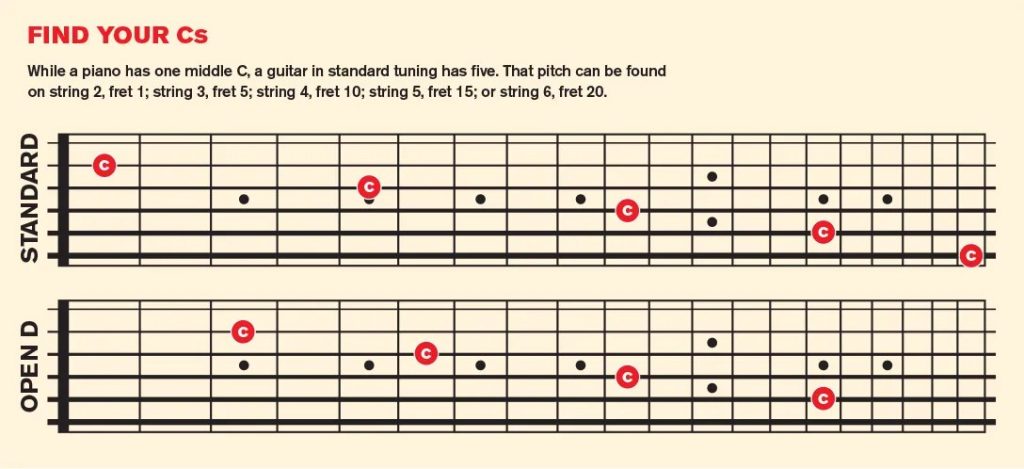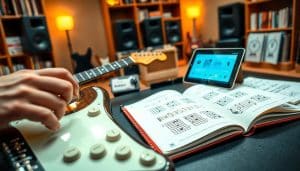Imagine yourself strumming away at a guitar, effortlessly playing your favorite songs. The best part of learning guitar is undoubtedly the ability to express yourself through music, but the process can sometimes be daunting. That’s where guitar tabs come in. These simple diagrams, consisting of numbers and lines, revolutionize the way beginners approach the instrument. With guitar tabs, you can easily learn to play songs without having to read traditional sheet music. Whether you’re a novice or an experienced player, tabs simplify the learning process and open up a world of musical possibilities for every aspiring guitarist.

1. What are Guitar Tabs?
1.1 Definition
Guitar tabs, also known as tablature, are a form of musical notation specifically designed for guitar players. Unlike traditional sheet music notation, which indicates the pitch, duration, and rhythm of individual notes, guitar tabs provide a simplified representation of a song by indicating the string and fret position to play on the guitar for each note.
1.2 Notation
Guitar tabs use a combination of numbers, letters, and symbols to represent the strings and frets on the guitar. Each line in the tab corresponds to a string on the guitar, while the numbers indicate the fret position where the note should be played. For example, a “0” indicates an open string, while a number like “3” or “7” represents the fret to press down on that string.
1.3 Purpose
The purpose of guitar tabs is to provide a straightforward and accessible way for guitar players of all skill levels to learn and play songs on the guitar. Tabs enable players to quickly grasp the string and fret positions required to play melodies, chords, solos, and other musical elements, without needing to read traditional sheet music notation.
2. The Advantages of Learning with Guitar Tabs
2.1 Simplified Notation
One of the most significant advantages of using guitar tabs is their simplified notation. While traditional sheet music can be overwhelming for beginners, guitar tabs provide a clear and concise representation of the required finger positions on the guitar. This simplicity allows aspiring guitarists to focus on learning the mechanics of playing without the added complexity of deciphering traditional notation.
2.2 Easy to Understand
Guitar tabs are designed to be user-friendly, making them easily understandable for players at any level. The use of numbers and symbols instead of complex musical notation eliminates the need for extensive music theory knowledge and allows beginners to start playing their favorite songs quickly. Even experienced musicians who are unfamiliar with guitar-specific notation can easily pick up guitar tabs and learn new songs.
2.3 Visual Representation
Another advantage of guitar tabs is their visual representation of the guitar neck. By providing fret numbers and string indicators, tabs offer a clear visual guide for players to navigate the finger positions on the guitar. This visual representation helps guitarists develop a deeper understanding of the instrument’s layout and fosters muscle memory, making it easier to switch between chords, play scales, and improvise.
2.4 Flexibility and Adaptability
Guitar tabs offer flexibility and adaptability, allowing players to interpret and customize songs based on their individual preferences. Unlike traditional sheet music, which often provides a fixed arrangement, tabs allow guitarists to modify chord voicings, add embellishments, or create unique arrangements. This flexibility makes guitar tabs a powerful tool for musicians seeking to put their personal touch on the songs they play.

3. How to Read Guitar Tabs
3.1 Basic Tablature Symbols
To read guitar tabs effectively, it’s essential to understand the basic tablature symbols commonly used. The most common symbols include numbers (representing fret numbers), “x” (indicating a muted or deadened string), and “-” or “|” (representing the lines separating strings and indicating measures or beats).
3.2 Strings and Fret Numbers
Guitar tabs consist of multiple lines, each representing one of the guitar strings. The bottom line usually represents the lowest-pitched string (usually the low E string), while the top line represents the highest-pitched string (typically the high E string). The numbers on each line indicate the fret position where the note should be played, with “0” representing an open string.
3.3 Rhythm and Timing Indications
While guitar tabs primarily focus on which notes to play and where to play them, they can also provide basic rhythm and timing indications. This can be done through additional symbols such as “h” (hammer-on), “p” (pull-off), “b” (bend), and “s” (slide). However, it’s important to note that guitar tabs may not always provide precise rhythmic information, especially for more complex rhythms, making it beneficial for players to use their ears and listen to the song alongside the tab.
4. Using Guitar Tabs for Chords and Melodies
4.1 Chord Tabs
Guitar tabs are an excellent tool for learning and playing chords on the guitar. Chord tabs show the finger positions required to play specific chord shapes, often indicating where to place fingers and which strings to strum or avoid. This makes it easier for beginners to understand and execute chord progressions in songs, allowing them to play along with their favorite tracks or accompany themselves while singing.
4.2 Melody Tabs
In addition to chords, guitar tabs can also represent melodies, solos, or individual riffs within a song. Melody tabs provide a note-by-note breakdown of a guitar part, allowing players to learn and recreate iconic guitar solos or memorable melodies accurately. By following the tab’s guidance on where to play each note, guitarists can gradually build their repertoire of songs and develop their soloing skills.

5. Finding Guitar Tabs Online
5.1 Guitar Tab Platforms and Websites
The internet offers a wealth of resources for finding guitar tabs. Numerous platforms and websites specialize in providing a vast collection of guitar tabs for all genres and skill levels. Websites such as Ultimate Guitar, Songsterr, and Guitar Pro offer extensive libraries of tabs, allowing guitarists to find tabs for popular songs, rare tracks, and everything in between.
5.2 Tab Transcriptions by Guitarists
Many accomplished guitarists and musicians share their own tab transcriptions online, providing valuable insights into their playing styles and techniques. These transcriptions often come with additional performance tips, explanations of tricky sections, and personal interpretations, adding depth to the learning experience.
5.3 Guitar Tab Communities
Online guitar tab communities are also great places to find tabs and engage with fellow guitar enthusiasts. These communities foster collaboration, allowing users to share their own tab transcriptions, seek advice, and connect with like-minded musicians. Participating in these communities can enhance the learning process by providing support, inspiration, and opportunities for collaboration.
6. Learning Songs with Guitar Tabs
6.1 Beginner-Friendly Songs
Guitar tabs provide an excellent starting point for beginners to learn their favorite songs. Many popular songs have simplified tab versions available, specifically tailored to accommodate learners with limited experience. These beginner-friendly tabs often focus on the fundamental chords and melodies of the song, allowing beginners to build confidence and progress at their own pace.
6.2 Intermediate and Advanced Songs
As guitarists advance their skills, they can tackle more complex songs using guitar tabs. Intermediate and advanced tabs offer greater challenges, incorporating intricate chord progressions, advanced techniques, and nuanced soloing. Working on these tabs helps players develop their technique, expand their musical vocabulary, and unlock new possibilities on the guitar.

7. Additional Tips and Tricks with Guitar Tabs
7.1 Using Tab Software and Applications
While physical or printable guitar tabs are readily available, using tab software or applications can provide additional benefits. Tab software, such as Guitar Pro or TuxGuitar, allows guitarists to visualize the tabs on the screen, play them back at variable speeds, and even access other instrument parts. These tools enhance the learning process, enabling users to hear how the tab sounds and providing valuable tools for practice and self-improvement.
7.2 Customizing Tabs to Fit Your Playing Style
One of the strengths of guitar tabs is their adaptability. Guitarists can customize tabs to suit their playing style or preferences. This may involve changing fingerings, altering chord voicings, or adding embellishments such as slides, bends, or vibrato. By personalizing tabs, musicians can infuse their unique expression into the music they play, fostering creativity and individuality.
7.3 Tab Annotations and Personal Preferences
As guitarists gain experience with tabs, they may develop their own system of annotations to enhance their learning process. These annotations can include symbols or notes to indicate specific techniques, fingerings, or variations. Developing a personal system of markings helps guitarists remember and internalize different playing techniques, making it easier to navigate through complex tabs and efficiently learn new songs.
8. Potential Limitations of Guitar Tabs
8.1 Lack of Music Theory Knowledge
While guitar tabs offer a simplified way to learn songs, they do not provide a comprehensive understanding of music theory. Relying solely on tabs may hinder a guitarist’s ability to communicate and collaborate with other musicians, as traditional music notation is widely recognized and understood across different instruments. Therefore, it’s essential for guitarists to seek a balance between using tabs and gaining a working knowledge of music theory.
8.2 Incomplete or Inaccurate Transcriptions
It’s important to note that not all guitar tabs available online are accurate or complete. Some tabs may contain errors or omissions, especially those transcribed by amateur musicians. It’s always a good idea to cross-reference multiple sources and, if possible, listen to the original recording of the song to ensure accuracy. Developing a discerning ear and critical approach to tabs can help guitarists identify and correct any discrepancies.

9. The Importance of Balancing Tabs with Music Notation
9.1 Understanding Traditional Music Notation
While guitar tabs are undoubtedly useful, understanding traditional music notation can greatly enhance a guitarist’s comprehensive musical understanding. Music notation provides a precise representation of pitch, rhythm, dynamics, and other musical elements that may not be fully captured in guitar tabs. Moreover, learning to read sheet music opens up the possibility of playing a broader range of musical genres and collaborating with musicians from diverse disciplines.
9.2 Enhancing Musical Understanding and Knowledge
By gaining proficiency in both guitar tabs and traditional music notation, guitarists can bridge the gap between different musical worlds. Music notation offers a more comprehensive understanding of music theory, enabling guitarists to analyze compositions and navigate complex musical structures. This knowledge goes beyond individual songs, empowering guitarists to become more well-rounded musicians and fostering growth and creativity in their musical journeys.
10. Tips for Transitioning from Guitar Tabs to Sheet Music
10.1 Learning Basic Music Theory
To ease the transition from guitar tabs to traditional sheet music, it’s beneficial for guitarists to start learning basic music theory concepts. This includes understanding note values, key signatures, scales, and intervals. With a solid foundation in music theory, guitarists can begin applying their knowledge to read sheet music more easily and comprehend the intricacies of musical compositions.
10.2 Practicing Reading Music Notation
Transitioning to sheet music also requires ample practice reading and interpreting musical notation. Dedicated practice sessions, especially with beginner-level sheet music, can gradually improve a guitarist’s reading skills. Starting with simple melodies and gradually progressing to more complex compositions helps build confidence and fluency in reading sheet music. Consistent practice and exposure to various musical genres can make the transition rewarding and enriching.
In conclusion, guitar tabs provide a user-friendly and accessible method for learning songs on the guitar. Their simplified notation, easy-to-understand format, and visual representation make them an excellent resource for guitar players of all skill levels. However, it’s important to balance the use of tabs with an understanding of traditional music notation and basic music theory to develop a well-rounded musical understanding. By leveraging the advantages of guitar tabs and incorporating broader musical knowledge, guitarists can expand their repertoire, enhance their playing techniques, and grow as versatile musicians.






